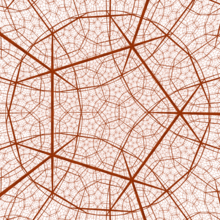Inmathematics, hyperbolic space of dimension n is the unique simply connected, n-dimensional Riemannian manifold of constant sectional curvature equal to −1.[1] It is homogeneous, and satisfies the stronger property of being a symmetric space. There are many ways to construct it as an open subset of 

It is also sometimes referred to as Lobachevsky spaceorBolyai–Lobachevsky space after the names of the author who first published on the topic of hyperbolic geometry. Sometimes the qualificative "real" is added to differentiate it from complex hyperbolic spaces, quaternionic hyperbolic spaces and the octononic hyperbolic plane, which are the other symmetric spaces of negative curvature.
Hyperbolic space serves as the prototype of a Gromov hyperbolic space, which is a far-reaching notion including differential-geometric as well as more combinatorial spaces via a synthetic approach to negative curvature. Another generalisation is the notion of a CAT(−1) space.
The -dimensional hyperbolic space or hyperbolic -space, usually denoted , is the unique simply connected, -dimensional complete Riemannian manifold with a constant negative sectional curvature equal to −1.[1] The unicity means that any two Riemannian manifolds that satisfy these properties are isometric to each other. It is a consequence of the Killing–Hopf theorem.
To prove the existence of such a space as described above one can explicitly construct it, for example as an open subset of with a Riemannian metric given by a simple formula. There are many such constructions or models of hyperbolic space, each suited to different aspects of its study. They are isometric to each other according to the previous paragraph, and in each case an explicit isometry can be explicitly given. Here is a list of the better-known models which are described in more detail in their namesake articles:
Hyperbolic space, developed independently by Nikolai Lobachevsky, János Bolyai and Carl Friedrich Gauss, is a geometrical space analogous to Euclidean space, but such that Euclid's parallel postulate is no longer assumed to hold. Instead, the parallel postulate is replaced by the following alternative (in two dimensions):
It is then a theorem that there are infinitely many such lines through P. This axiom still does not uniquely characterize the hyperbolic plane up to isometry; there is an extra constant, the curvature K < 0, that must be specified. However, it does uniquely characterize it up to homothety, meaning up to bijections that only change the notion of distance by an overall constant. By choosing an appropriate length scale, one can thus assume, without loss of generality, that K = −1.
The hyperbolic plane cannot be isometrically embedded into Euclidean 3-space by Hilbert's theorem. On the other hand the Nash embedding theorem implies that hyperbolic n-space can be isometrically embedded into some Euclidean space of larger dimension (5 for the hyperbolic plane by the Nash embedding theorem).
When isometrically embedded to a Euclidean space every point of a hyperbolic space is a saddle point.
The volume of balls in hyperbolic space increases exponentially with respect to the radius of the ball rather than polynomially as in Euclidean space. Namely, if is any ball of radius in then:
The hyperbolic space also satisfies a linear isoperimetric inequality, that is there exists a constant such that any embedded disk whose boundary has length has area at most . This is to be contrasted with Euclidean space where the isoperimetric inequality is quadratic.
There are many more metric properties of hyperbolic space that differentiate it from Euclidean space. Some can be generalised to the setting of Gromov-hyperbolic spaces, which is a generalisation of the notion of negative curvature to general metric spaces using only the large-scale properties. A finer notion is that of a CAT(−1)-space.
Every complete, connected, simply connected manifold of constant negative curvature −1 is isometric to the real hyperbolic space Hn. As a result, the universal cover of any closed manifold M of constant negative curvature −1, which is to say, a hyperbolic manifold, is Hn. Thus, every such M can be written as Hn/Γ, where Γ is a torsion-free discrete groupofisometriesonHn. That is, Γ is a latticeinSO+(n, 1).
Two-dimensional hyperbolic surfaces can also be understood according to the language of Riemann surfaces. According to the uniformization theorem, every Riemann surface is either elliptic, parabolic or hyperbolic. Most hyperbolic surfaces have a non-trivial fundamental group π1 = Γ; the groups that arise this way are known as Fuchsian groups. The quotient space H2/Γ of the upper half-plane modulo the fundamental group is known as the Fuchsian model of the hyperbolic surface. The Poincaré half plane is also hyperbolic, but is simply connected and noncompact. It is the universal cover of the other hyperbolic surfaces.
The analogous construction for three-dimensional hyperbolic surfaces is the Kleinian model.